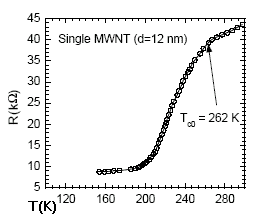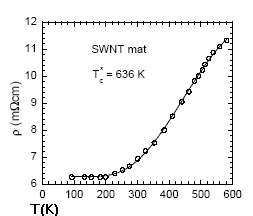Room-Temperature Superconductivity
in


Room-temperature superconductivity. It's the holy grail of solid-state physics. A means of conducting electricity without any losses whatsoever at temperatures hundreds of degrees higher than what is required of today's "warm superconductors" - the copper perovskites. So, is this even possible? Can science achieve what seems an unattainably lofty goal?
Claims of room-temperature superconductivity have been around for years. Everything from metallic hydrogen to oxidized polypropylene has been run up the flagpole. Now a California State University professor claims room-temperature superconductors (RTSC) have been right under our noses since 1985 in the form of carbon nanotubes. Nanotubes are a type of "fullerene" - carbon atoms joined in spherical and tubular shapes unimagined until their accidental discovery in 1985 by Robert F. Curl, Jr. and Richard E. Smalley of Rice University and Professor Sir Harold W. Kroto of the University of Sussex in Brighton, England.
Professor Guo-Meng (Peter) Zhao claims that there exist more than 20 markers in carbon nanotubes which demand they once-and-for-all take their rightful place on the throne of room-temperature superconductivity. But, if they are indeed RTSC's, why hasn't the scientific community signed-off on them? And, why isn't the private sector clamoring to install them in our cell phones and computers and everything else that could benefit from such a miracle discovery? We wanted to know, too. So we asked Dr. Zhao some pointed questions about his claim. And here's what he had to say.
Q. What is the crux of your claim?
A. It is well known that copper-based perovskite oxides rightly enjoy consensus as high-temperature superconductors on the basis of two signatures: Meissner effect and zero resistance. In contrast, I provide over twenty signatures for room temperature superconductivity in carbon nanotubes.


Q. You assert that diamagnetism is present. What would it take to levitate a rare-earth magnet over a nanotube bundle?
A. A big bundle of superconducting MWNT's can levitate a rare-earth magnet. The Meissner effect is less visible because the diameters of nanotubes are much smaller than the penetration depth. Below 400 K, diamagnetic susceptibility strongly depends on magnetic field in the low field range in unprocessed MWNT ropes where some of tubes are physically coupled. The resistance transitions observed in several multi-wall nanotube ropes are consistent with Tc's of about 700 Kelvin.
Q. Hooking up leads to these nanotubes could be problematic. How would you suggest eliminating resistance at the contact points?
A. The on-tube resistance is negligibly small, but the tunneling resistance exists intrinsically for a finite number of transverse channels. Only if you can make a large bundle containing over 10,000 channels, you will get nearly zero tunneling resistance for ideal contacts. Anyway, zero contact resistance is not required for most applications.
Q. Has your work undergone peer review? If so, by whom?
A. I have submitted two of my papers to PRB (Physical Review B) and two to PRL (Physical Review Letters). There was also a piece in New Scientist. I just came back from a conference sponsored by NATO, where I was invited to give a talk on RTSC. There were about ten superconductivity physicists including four world-leading theorists in the superconductivity field, but none of them raised any questions that can undermine my arguments. I was also told in the conference that a Russian group has been successful in preparing large bundles of MWNTs that exhibit a large Meissner effect at room temperature.
Q. Where do we go from here? It seems we are in the same position as with ballistic quantum wire. How do we bring it to the marketplace?
A. Longer ballistic quantum wires will have finite resistances, but superconducting carbon nanotubes and their bundles can have zero or near zero resistivity even if the tubes are long. Although there is still long way to go for applications in electrical transmission and magnets, there will be many applications in microelectronics in the near future.
...data analyses unambiguously confirms superconductivity above room temperature. The resistive transitions and the Meissner effect are quantitatively explained in terms of superconductivity.
© 2004 Superconductors.ORG. All rights reserved.
 BACK to the "News" page at Superconductors.ORG
BACK to the "News" page at Superconductors.ORG